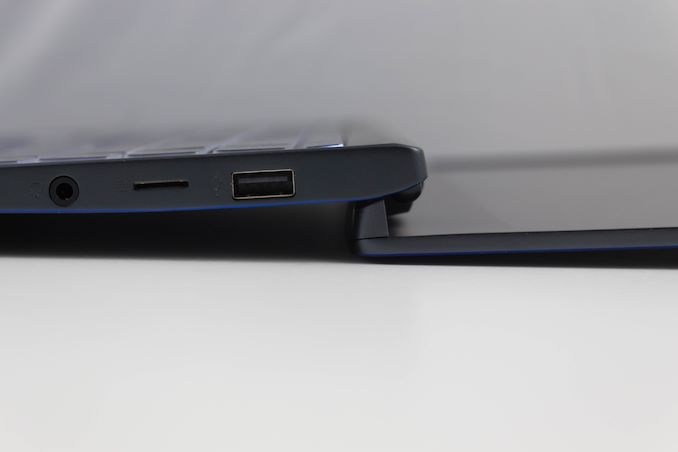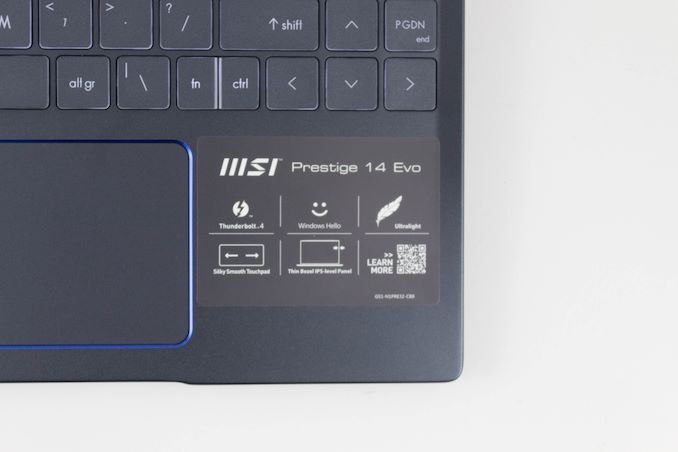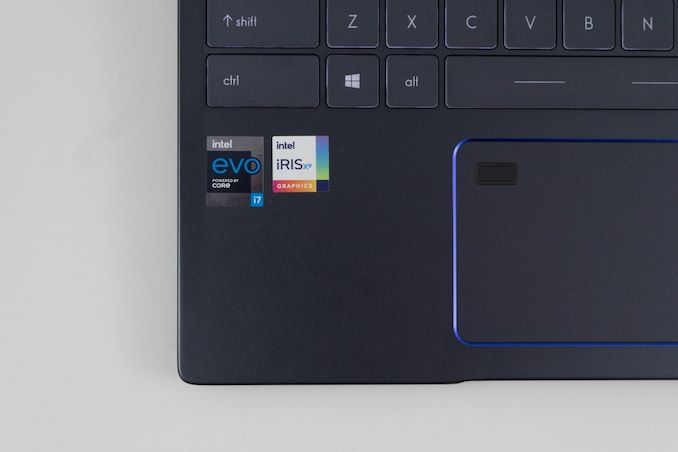The MSI Prestige 14 Evo Review: Testing The Waters Of Tiger Lake
by Brett Howse on December 17, 2020 10:00 AM EST- Posted in
- Laptops
- Intel
- MSI
- Tiger Lake
- Notebook
Final Words
When a company produces some of the best gaming laptops in the industry decides to take a step back into the consumer world of Ultrabooks, expectations are high. MSI has some very stiff competition though, with some fantastic designs over the last year or two really pushing the Ultrabook to new highs. MSI’s Prestige 14 Evo offers some great features, but is also let down in a couple of key areas.
While MSI has built the Prestige out of quality materials, the overall design just can’t match laptops like the Dell XPS 13, HP Spectre, or Lenovo’s ThinkPad X1 Carbon. By comparison, the MSI design feels very safe, and a bit on the boring side, which is a real surprise when you consider some of the dramatic gaming systems MSI has produced. It may seem a bit harsh to continually harp on it, but the 16:9 display is also a drawback, and creates a lot of unused space when looking at the display. MSI could have easily fit a 16:10 display into the same size chassis, providing the end user with some more vertical room for productivity. Finally, the decision to leverage a lifting hinge, which raises the rear of the device up to 5° in the guise of making a better typing experience is ergonomically a poor design.
 The hinge allows for 180° opening, but the laptop is not able to lay flat
The hinge allows for 180° opening, but the laptop is not able to lay flat
Coupled to the design issues is a poor keyboard. The layout is not standard, but could be adjusted to, but the key feel is just not great. There is not a lot of feedback from the keys when using them, and despite the reasonable travel, it ends up being a rather unsatisfying experience. The biggest tragedy here is that MSI offers some of the best laptop keyboards on the market in their gaming laptops, but has chosen a much different design for the Prestige lineup.
As one of the launch devices for Intel’s Evo platform though, the MSI does deliver. The Prestige 14 Evo offers very solid battery life, excellent Wi-Fi performance, and quick charging. It also features Windows Hello with your choice of either IR or fingerprint, and more choice is never a bad thing.
This is our first production device to feature Intel’s newest Tiger Lake platform, and it is amazing how much more performance it offers over the outgoing Ice Lake design. Despite offering just four CPU cores compared to AMD’s Renoir SoC which can have up to eight, it offers superior single-core performance, and can almost match Renoir in multi-threading tasks. Although the Willow Cove CPU cores are only a slight change from last year’s Sunny Cove design, the new 10 nm SuperFin process allows Intel to drive frequencies much higher than they could achieve with Ice Lake.
The cost of that extra frequency though is power draw. On sustained loads, the MSI Prestige allowed for around 30 Watts of power to the CPU package in its maximum performance mode. Sound levels were extreme, and the CPU temperature was bouncing off its limit, but MSI does allow its owners to extract everything out of the device when needed. Happily, you can also switch to a silent mode which is more enjoyable to use for most tasks, but the performance is there when it is needed.
Intel’s new Xe graphics is also a major leap forward in terms of integrated graphics performance. The new larger, faster graphics package could easily double the performance of last year’s Ice Lake design in many real-world games. Across the board, Intel was able to out-muscle AMD’s Vega graphics in Renoir, which did not seem possible when you think of the performance of Intel’s long-used UHD graphics platform it had used previously. While not quite matching low-end gaming systems, Intel’s Xe does at least allow for some gaming to be done with no extra dGPU necessary. This should be an exciting space to watch evolve now.
Another unexpected surprise was to see MSI had calibrated the display on the Prestige 14. Although the 16:9 is a let-down, there have only been a couple of companies to do this, and it makes a big difference for the end user. MSI somewhat markets the Prestige as a content creator device, so it is excellent to see them take that to heart in terms of color accuracy on the display.
But the one area where MSI has done very well is on price. As of this writing, the Prestige 14 Evo starts at just $1149 USD, and that includes the Core i7-1185G7, 16 GB of LPDDR4X RAM, and a 512 GB SSD. Due to Intel now segmenting its CPU stack with differing GPU sizes, which followed what AMD has done with Vega, the starting price is a very compelling package. You can pick a couple of colors, and a couple of drive sizes, but unlike most of the competition, the base model is pretty much fully decked out. Despite a design that can’t quite match some of the others in the market, MSI’s Prestige 14 Evo does pack a punch for a reasonable price.













63 Comments
View All Comments
Vitor - Thursday, December 17, 2020 - link
Im just glad the display has decent accuracy.Teckk - Thursday, December 17, 2020 - link
This is a really good enough laptop for a lot of people and surprisingly good graphics performance by Intel. Is 1 Watt display not a requirement for Evo?gizmo23 - Thursday, December 17, 2020 - link
This laptop with 16:10 ratio display = take my money. As it is, I think my XPS will have to last a bit longer.s.yu - Friday, December 18, 2020 - link
My 2019 XPS132N1's digitizer experience really sucks, but I looked around the market and nothing really serves as a solid upgrade. If the latest Surface Book weren't so expensive with soon to be outdated graphics that would be my first choice.oRAirwolf - Saturday, December 19, 2020 - link
Offering a laptop with a 16x9 display when it's almost 2021 is pretty well. Get with the times MSI. 16x9 is fine on a large display, but laptops greatly benefit from some extra vertical real estatemobutu - Thursday, December 17, 2020 - link
almost bought this, luckily that I saw at the last time that, at the begining of 2021, it doesn't have at least one USB 3.x.A port ... good thing it has a TOTALLY USELESS 2.0.A one.I would torture the guys at msi for this stupid decision. what a bunch of retards .
ozzuneoj86 - Thursday, December 17, 2020 - link
I am totally confused by this decision as well. What a complete waste of a computer. What are you supposed to do with external storage devices that connect with USB A? Carry around adapters, or just deal with USB 2.0 speeds? In 2021!?!?And as a general complaint with most "nice" laptops these days, what if you use a mouse that connects via USB??? No flash drives then?
Might as well be an Apple product.
And no, it isn't a typo. The MSI site shows this across the board for all configurations of this model "USB: 1x USB 2.0"
Yakinabe - Thursday, December 17, 2020 - link
The USB 2.0 port is for your mouse. That's why it's on the right side. For faster peripherals like storage devices, it has two Thunderbolt ports. If you insist on keeping your legacy storage devices then yeah, you'd need to get a USB-C cable for your device, or carry an adapter.CharonPDX - Thursday, December 17, 2020 - link
Or use one of my dozens of USB-A 3.0 64-256 GB thumb drives. Or my external Blu-ray drive that has a tethered cable.Modern EFI and OSes can handle running a keyboard or mouse just fine over USB 3.0/3.1/3.2/4. There is no reason to continue to offer a USB 2.0 USB port.
The_Assimilator - Thursday, December 17, 2020 - link
While I agree that the choice of USB 2.0 is bizarre, my guess is that it's due to SOC peripheral bandwidth limitations - those two TB4 ports consume a LOT of PCIe lanes, and IIRC Tiger Lake has a relatively low PCIe lane count due to thermal and power constraints.